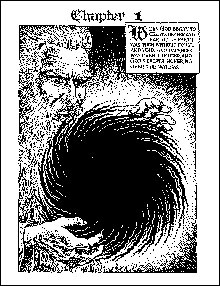
AND SO IT BEGINS R. Crumb applies his graphic talent to a holy book. |
The Book of Genesis seems like inherently good fodder for R. Crumb's satirical debasement. After all, his infamous crackpot guru Mr. Natural looks plucked directly from the Old Testament, with his long white beard and yellow robe. But, surprisingly, the father of underground cartoon culture, and one of the most celebrated comic-book artists ever, has illustrated the sacred book while remaining as faithful to the text as possible. His depiction of God is no mischievous stoner hedonist, but a stoic and dominating force. In his introduction to the epic, Crumb clarifies that he believes the text to be the words of men, and not the work of God, but that he reveres the power of the book as it permeates "historical consciousness," and that he approached the work as an illustration job, without intent to ridicule or offend.The original drawings from Crumb's 2009 adaptation are displayed in a linear fashion at the Bowdoin College Museum of Art. Winding around the partitions and walls in the space are 207 pages portraying all 50 chapters of the first book of the Bible. The raw precision of Crumb's hand and his meticulous craft can be truly appreciated in the saturated black ink, pencil marks, and correction fluid that sculpt his strips. The text is drawn from the King James version and Robert Alter's 2004 translation of the book, and nothing is left out. Four years of effort densely pack each frame with gorgeously rendered visual information.
It's a peculiar project for an artist known for his ripping profanities and anarchical cultural commentary — to tackle a ubiquitous sacred text without siccing his cool but fraught irreverence on its beloved characters. Adam and Eve, Cain and Abel, and Abraham and Sarah, who often exist in intangible vagueness, are given relatable human faces. Crumb lends flesh and buxom form to the names and events of the first book of the Old Testament, and places them in diligently researched landscapes and costumes, with overtly Semitic appearances. The images bolster and inflate the stories, making the situations accessible, compelling, and at times, pulpy. While he may not trivialize or mock the events in the book, he certainly does not steer away from their drama.
Here we see Crumb's sincerity. Hints at humor are inevitable, simply due to the weight and dirtiness of Crumb's line and nervous hatchmarks, but overall the project reads as his genuine attempt to make sense of the hallowed text, to contextualize it and make it more human. Sex and violence are depicted graphically, but not sensationally so. Crumb is clearly not intending to hyperbolize or irritate, nor to illuminate gaps in logic or contradictions in morality. He infuses his imagery with fantasy and psychedelia only when the text is lost without it, and doesn't milk the creative liberties an illustrator might take when exploring such a vague and loaded text. His characters and landscapes are gritty and coarse as all his drawings are, reflecting the twitchy messiness and vulgarity the artist clearly takes from humanity. His illustrations are a meditation, curbing his idiosyncratic cynicism and earnestly channeling his gristly perspective through the open lens of the book's narrative. It is the artist's plight for understanding, a deconstruction of one of history's most entrenched cultural narratives, perhaps in an attempt to grasp the reason for its cultural gravity. It is also a reflection on the subjectivity and nuance of interpretation and analysis, a nod to the fact that when this text, which is frail and ambiguous in places, has some meat on its bones, the story can look any number of ways, and can be used or appropriated in just as many. It's as though Crumb's subversion comes into play just by connecting the dots and asking, Is this really what you thought it would look like?